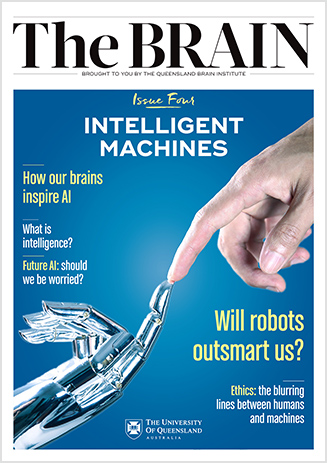Unlike our own intelligence, artificial intelligence (AI) isn’t driven by a survival instinct. Yet human-like robots and machines that aim to out-compete humanity are typically what we conjure up when thinking of AI. The fact is, AI is all around us and we often use it without realising. Every time you ask Siri to do a task, use a Snapchat filter, have junk mail filtered from your inbox, or get a traffic update on Google Maps, AI is at work.
First, let’s be clear on what intelligence is: the ability to acquire knowledge through learning, and to apply that knowledge to solve problems. Artificial intelligence is the use of a program, or algorithm, to perform a task which requires humans to use our intelligence.
Just as we use our brains to learn from new information gathered by our senses, AI learns from information fed to it—either many examples of an image, say, or the rules of a game—and processed according to how it is programmed. When AI is programmed to follow an algorithm, it is called machine learning. AI can handle massive amounts of data that our brains simply cannot cope with.
For the simple task of identifying a cat, humans take into consideration the shape and physical attributes and check this against our knowledge of what a cat is, based on our memories and experience.
Importantly, though, our learning naturally involves building abstract representations, meaning we can recognise a cat even if we see only the back legs and a furry tail, or if we see a drawing of a circle for a head and two triangles for ears. For AI to identify a cat, you would feed it millions of cat images and train it to recognise particular pixel patterns that form a cat shape.
This is exactly what Google did in 2012, using a type of machine learning known as a deep neural network (inspired by the brain) to develop a program that learned to identify images that contained cats. The program was not fed the rules that cats have four legs, a tail, two ears and so on, but because the images were labelled as containing or not containing cats, the program was able to learn the visual concept of a cat. When given a new image, the program could label it as cat-containing or not.
In other words, this Google AI acquired information from the images, learned to identify cats, and could then apply rules to solve the question of which new images contained cats. But unlike our brains, the AI doesn't really know what a cat is, or understand it can have abstract representations or is an object that changes shape.
AI decoded
AI can be roughly divided into symbolic or rules-based computing—typical 'if-then' statements—and machine learning, where AI is programmed with an algorithm that can modify itself as it gains new information.
There are different ways machine learning can be employed: deep learning by using artificial neural networks, reward-based learning, and learning based on statistical principles. Many AI programs are used for analysing and processing images or speech or extracting information from them. Deep learning is often used for making predictions, like medical diagnoses or possible credit card fraud.
Limits of today's AI
➟ Enormous data and computational requirements
➟ Like a black box: Difficult to know how or why a deep learning AI program produced a particular outcome
➟ Difficulty understanding irony, humour, sarcasm or metaphors
➟ Bias: AI performance is based on data that contains human biases
➟ Interpreting tone and intentions from speech
➟ The need for human supervision to set the rules and goals
➟ Difficulty creating or understanding meaningful art or music, novels or poetry
AI Definitions
Machine learning
Computer-based learning achieved by following an algorithm (a set of instructions or rules) to maximise the chance of a prediction being correct. Any program that improves its performance based on new inputs is an example of machine learning. It may involve artificial neural networks, but doesn’t have to.
Artificial neural network
A computer-based system to process information, loosely modelled on the brain’s architecture. It typically involves units, or ‘neurons’ connected to one another, comparable to how the brain’s neurons communicate. Artificial neural networks are highly simplified, abstract forms of brain networks.
Deep learning
A type of machine learning that uses ‘deep’ neural networks. The word ‘deep’ refers to the many layers in the neural network. Deep learning is how most of today’s artificial intelligence programs operate.
Neural
Refers to anything relating to neurons, or the nervous system.
Neuron
Also called a nerve cell. It is the basic unit of our nervous system.
Reinforcement or reward-based learning
Using rewards or penalty to guide learning. With the aim of maximising its reward and minimising mistakes, the network learns an approach that meets its goal.

